 Website:
Mehler Texnologies
Website:
Mehler Texnologies
Group: Bonar
Catalog excerpts
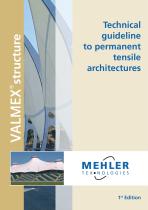
Technical guideline to permanent tensile architectures
Open the catalog to page 1
The following information is intend- ed as a basic guide for architects and engineers to assist in concept design and in specifying materials, in order to get enough preliminary background for planning activities. Our intention is to support architects, engineers and generally all those who approach the technical and commer- cial aspects of membrane structures The Fabric - Material properties 5 Special materials application - Facades 11 Frequently asked questions 20
Open the catalog to page 2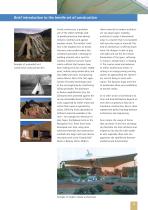
Brief introduction to the tensile art of construction Example of primordial tent construction using animal skin. Tensile architecture is probably one of the oldest methods used to provide protection from adverse climatic conditions and against predator attack. The humble ‘conic’ tent is the simplest form of tensile structure, and excelled where two conditions prevailed: a shortage of building material and a need for mobility. Evidence has been found which conrms that humans have been making tents for at least 15,000 years, initially using animal skins, and only 3000 years later,...
Open the catalog to page 3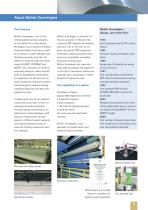
About Mehler Texnologies Mehler Texnologies − always „one of the rst“ The Company Mehler Texnologies is one of the internationally leading companies on the market for coated fabrics. We produce in our facilities in Hückelhoven and Fulda in Germany as well as in Lomnice in Czech Republic and distribute annually more than 50 million m² material under the brand names VALMEX®, POLYMAR® and AIRTEX®. Our customers are found in processing industries. More than 60 years of development and production experience are the basis for our mature products. Continued research and development improve...
Open the catalog to page 4
The Fabric – Materials properties adhesion layer base fabric adhesion layer main coat primer top coat Typical section of Mehler coated PVC-Polyester fabric MEHATOP F immediatly after soiling after 1d at 70°C after 2d at 70°C after 3d at 70°C after 7d at 70°C after 10d at 70°C after 14d at 70°C not cleaned Low-wick base fabric generate a barrier to inltration of liquids assuring the original membrane properties. The textile industry is constantly improving the existing materials. Mehler Texnologies as a pioneer fabric producer is continuously increasing and perfecting those top coat primer...
Open the catalog to page 5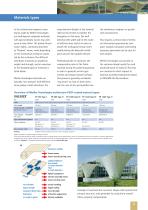
Materials types In the architectural segment, membranes made by Mehler Texnologies are multilayered composite materials with special densely woven low-wick yarns in base fabric. The double thread woven fabric, commonly described as “Panama” weave, varies depending on the mechanical resistance requested by the customers. The different membrane materials are graded by weight and strength, and an overview of the standard types of materials is listed below. Mehler Texnologies materials are basically ”pre-stressed” with different force grades in both directions. The warp direction (length of the...
Open the catalog to page 6
Advantages of weldable PVDF coated fabrics Mehler Texnologies, a pioneer in PVC-PES coatings, introduced more than 14 years ago weldable PVDF coated membrane. In our opinion, the textile industry should provide products to the market which can perform without the need to be modied, ground or manipulated by the fabricator. The industry should assume in full the material properties responsibility, not delegate this to additional substances, to manipulations of the surface, to the uncontrolled machines operation capability or simply to human factor. It is wrongly assumed that the weldability...
Open the catalog to page 7
Comparison PVC/PES-Fabrics with weldable/ non-weldable PVDF coating Comparison PVC/PES-Fabrics with weldable/ non-weldable PVDF coating PVC/PES-PVDF non weldable PVC/PES-PVDF Product weldable Specification MATERIAL PROPERTIES Basic fabric Type of coating Top-coating variation Total weight Tensile strength warp Tensile strength in fill Material roll width Thickness Translucence Flammability PES (Polyester) PVC (Polyvinylchlorid) Primer +blended PVDF (polyvinylidene floride) (Mehatop F) approx. 650 to 1550 [g/m²] approx. 2500 to 9800 [N/5 cm] PES (Polyester) PVC (Polyvinylchloride) Variable...
Open the catalog to page 8
General performances Wind A frequently asked question is if membrane structures are suitable for permanent installation on windy sites. The answer is usually „yes, as long as the project is properly engineered”. Today it is possible to generate computer analysis of the different load cases which show that the wind load is the major load case in any scenario. The detailing of the ttings and surrounding structure play an important role and needs to take into account the maximum deections of the membrane. Under extreme circumstances the engineering and material choice has to be carried out...
Open the catalog to page 9
General performances Sun, humidity and pollution Thermal insulation Mehler Texnologies structural fabrics incorporate UV stabilisers that protect colour and base cloth, slowing the rate of degradation. A single layer of VALMEX® FR 1000 membrane with a of 1050 g/m2 has a U-value of approx. 5.7 W/m2K (DIN 52611). In this respect it is very similar to glass. A twin skin with a 200 mm air gap will give an approximate U-value of 2.7 W/m2K. Natural lighting is now a rmly established concept in architecture, as governmental institutions encourage energy saving processes. The most common PVC-PES...
Open the catalog to page 10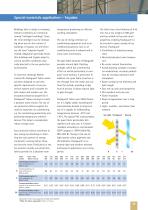
Special materials application − Façades Buildings able to adapt to changing climatic conditions are commonly termed “intelligent buildings”. Since the term intelligent can be misleading when used in the context of buildings or façades, we will better use the term “adaptive façade” instead. Adaptation generally means that buildings and façades adapt to current weather conditions, especially directed to the sun protection functionality. To meet this challenge Mehler created the Flashguard® fabric which has been designed to meet the specic requirements of sun protection systems and is suitable...
Open the catalog to page 11All Mehler Texnologies catalogs and technical brochures
-
VALMEX® tent
8 Pages
-
VALMEX® boat
6 Pages
-
VALMEX® MEHATOP® N
6 Pages
-
VALMEX® façade
6 Pages
-
POLYMAR® scrim cristal
6 Pages
-
VALMEX® sol-boutique
6 Pages
-
POLYMAR® tarp
6 Pages
-
VALMEX® MEHATOP® F1
8 Pages
-
FR color classic
8 Pages
-
VALMEX smart
2 Pages
-
VALMEX Boat Yukon
2 Pages
-
VALMEX
2 Pages
-
MEHATOP F
10 Pages
-
MEHATOP-N
2 Pages
















